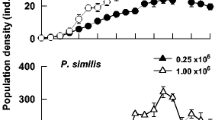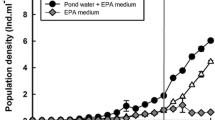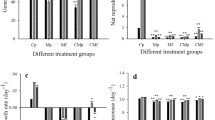Abstract
Effects of temperature (18, 24, and 30°C), salinity (5–40 ppt, five intervals) and algal foods (Synechococcus sp., Chlorella pyrenoidosa, Isochrysis zhanjiangensis, Dunaliella salina and Tetraselmis cordiformis) on the life table demography of six geographical Brachionus plicatilis sensu stricto clones, which had been identified according to the prevalent taxonomy and biometric analysis of B. plicatilis sensu lato, were studied. The results showed that temperature, salinity and temperature × salinity significantly influenced the life history parameters. Genotype (clone) had no effect on the population growth rate but did influence the net reproductive rate, generation time and lifespan. All rotifer clones showed the expected increase in population growth rate with increasing temperature. B. plicatilis s. s. attained a higher population growth rate at low–medium salinities (5–20 ppt) than at high salinities (25–40 ppt). The equivalent spherical diameter (ESD) of food algae, salinity and ESD × salinity had significant effects on the life history parameters. In this case, genotype had no effect on population growth rate, net reproductive rate and generation time but did influence lifespan. The population growth rate of B. plicatilis s. s. evaluated against particle retention spectrum of algae at two salinities resulted in bell-shaped curves. Dunaliella salina with an ESD = 7.7 μm was considered to be the best food for B. plicatilis s. s. while Synechococcus appeared to be an inadequate food algae.





Similar content being viewed by others
References
Bayly IAE (1972) Salinity tolerance and osmotic behavior of animals in athalassic saline and marine waters. Annu Rev Ecol Syst 3:233–268
Ciros-Pérez J, Gómez A, Serra M (2001a) On the taxonomy of three sympatric species of the Brachionus plicatilis (rotifer) complex from Spain, with the description of B. ibericus n. sp. J Plankton Res 23:1311–1328
Ciros-Pérez J, Carmona MJ, Serra M (2001b) Resource competition between sympatric sibling rotifer species. Limnol Oceanogr 46:1511–1523
Dumont H (1977) Biotic factors in the population dynamics of rotifers. Arch Hydrobiol Beih 8:98–122
Edmondson WT (1945) Trophic relations of the zooplankton. Trans Am Microsc Soc 76:225–245
Epp RW, Winston PW (1977) Osmotic regulation in brackish-water rotifer Brachionus plicatilis (Müller). J Exp Biol 68:151–156
Epp RW, Winston PW (1978) The effect of salinity and pH on the activity and oxygen consumption of Brachionus plicatilis (Rotifera). Comp Biochem Physiol 59A:9–12
Galkovskaja GA (1987) Planktonic rotifers and temperature. Hydrobiologia 147:307–317
Gómez A, Snell TW (1996) Sibling species and cryptic speciation in the Brachionus plicatilis species complex (Rotifera). J Evol Biol 9:953–964
Gómez A, Serra M, Carvalho GR, Lunt DH (2002) Speciation in ancient cryptic complexes, evidence from the molecular phylogeny of Brachionus plicatilis (Rotifera). Evolution 56:1431–1444
Hansen B, Wernberg-Moller T, Wittrup L (1997) Particle grazing efficiency and specific growth effciency of the rotifer Brachionus plicatilis. J Exp Mar Biol Ecol 215:217–233
Herzig A (1983) Comparative studies on the relationship between temperature and duration of embryonic development of rotifers. Hydrobiologia 104:237–246
Hirayama K, Rumengan IFM (1993) The fecundity patterns of S and L type rotifers of Brachionus plicatilis. Hydrobiologia 255/256:153–157
Hirayama K, Takagi K, Kimura H (1979) Nutritional effect of eight species of marine phytoplankton on population growth of the rotifer Brachionus plicatilis. Bull Jap Soc Sci Fish 45:11–16
Hotos GN (2002) Selectivity of the rotifer Brachionus plicatilis fed mixtures of algae species with various cell volumes and cell densities. Aquac Res 33:949–957
Ito T (1955) Studies on the “Mizukawari” in eel culture ponds. I. The feeding activity of Brachionus plicatilis on phytonannoplankton. Rep Fac Fish Prefect Univ Mie 2:162–167
Knowlton N (1993) Sibling species in the sea. Annu Rev Ecol Syst 24:189–216
Korstad J, Olsen Y, Vadstein O (1989) Life history characteristics of Brachionus plicatilis (rotifera) fed different algae. Hydrobiologia 186/187:43–50
Krebs CJ (1994) Ecology: the experimental analysis of distribution and abundance, 4th edn. Harper Collins College Publ, New York, pp 168–181
Lourenço SO, Marquez UML, Mancini-Filho J, Barbarino E, Aidar E (1997) Changes in biochemical profile of Tetraselmis gracilis I. Comparison of two culture media. Aquaculture 148:153–168
Lowe CD, Kemp SJ, Bates AD, Montagnes DJS (2005) Evidence that the rotifer Brachionus plicatilis is not an osmoconformer. Mar Biol 146:923–929
Lubzens E (1987) Raising rotifers for use in aquaculture. Hydrobiologia 147:245–255
Lubzens E, Minkoff G, Marom S (1985) Salinity dependence of sexual and asexual reproduction in the rotifer Brachionus plicatilis. Mar Biol 85:123–126
Lubzens E, Tandler A, Minkhoff G (1989) Rotifers as food in aquaculture. Hydrobiologia 186/187:387–400
Lubzens E, Zmora O, Barr Y (2001) Biotechnology and aquaculture of rotifers. Hydrobiologia 446/447:337–353
Miracle MR, Serra M (1989) Salinity and temperature influence in rotifer life history characterristics. Hydrobiologia 186/187:81–102
Meyer JS, Ingersoll CG, McDonald LL, Boyce MS (1986) Estimating uncertainty in population growth rates: Jackknife vs. Bootstrap techniques. Ecology 67:1156–1166
Ortells R, Gómez A, Serra M (2003) Coexistence of cryptic rotifer species, ecological and genetic characterization of Brachionus plicatilis. Freshw Biol 48:2194–2202
Pontin RM (1966) The osmoregulatory function on the vibratile flames and the contractile vesicles of Asplanchna (Rotifera). Comp Biochem Physiol 17:1111–1126
Rothhaupt KO (1990a) Differences in particle size-dependent feeding efficiencies of closely related rotifer species. Limnol Oceanogr 35:16–23
Rothhaupt KO (1990b) Population growth rates of two closely related rotifer species, effects of food quantity, particle size, and nutritional quality. Freshw Biol 23:561–570
Rumengan IFM, Hirayama K (1990) Growth responses of genetically distinct S and L type rotifer (Brachionus plicatilis) strains to different temperatures. In: Hirano R, Hanyu I (eds) The second Asian fisheries forum. Asian Fisheries Society, Manila, Philippines, pp 33–35
Snell TW (1986) Effect of temperature, salinity and food level on sexual and asexual reproduction in Brachionus plicatilis (Rotifera). Mar Biol 92:157–162
Snell TW, Bieberich CJ, Fuerst R (1983) The effects of green and blue-green algae diets on the reproductive rate of the rotifer Brachionus plicatilis. Aquaculture 31:21–30
Sudzuki M (1987) Intraspecific variability of Brachionus plicatilis. Hydrobiologia 147:45–47
Vadstein O, Øie G, Olsen O (1993) Particle size dependent feeding by the rotifer Brachionus plicatilis. Hydrobiologia 255/256:261–267
Yin XW, Zhao W (2005) Species composition and population dynamics of rotifer Brachionus plicatilis complex in a coastal lagoon. J Dalian Fish Coll 20:1–10
Acknowledgments
We are grateful to the anonymous referees for improving our manuscript. We also thank G. W.Jia for technical assistance during the investigation. This study was supported by Natural Science Foundation (002119, 20020299) of Liaoning Province, China.
Author information
Authors and Affiliations
Corresponding author
Rights and permissions
About this article
Cite this article
Yin, X.W., Zhao, W. Studies on life history characteristics of Brachionus plicatilis O. F. Müller (Rotifera) in relation to temperature, salinity and food algae. Aquat Ecol 42, 165–176 (2008). https://doi.org/10.1007/s10452-007-9092-4
Received:
Accepted:
Published:
Issue Date:
DOI: https://doi.org/10.1007/s10452-007-9092-4




